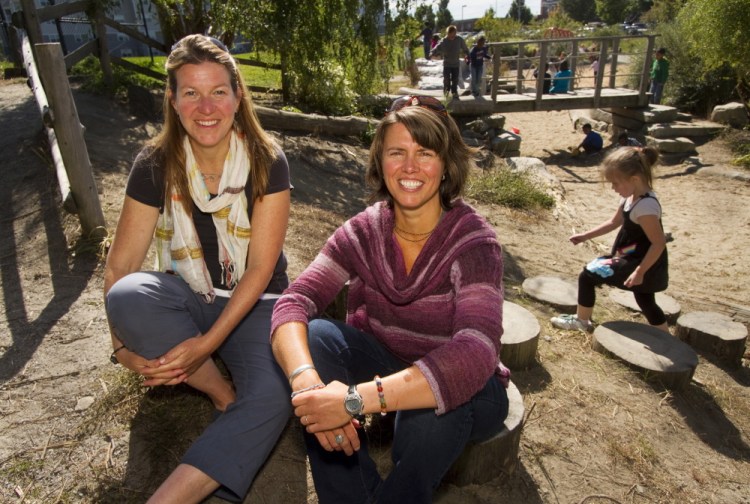Think of a school playground, and chances are you envision a swing set, a slide, maybe some monkey bars. But these days, around Portland, you’re more likely to find trails, ponds, fountains, greenhouses, fairy gardens, vegetable gardens, climbing walls and other nature-friendly features. It’s probably the work of the School Ground Greening Coalition, a partnership of individuals and public and private organizations trying to get recess-starved schoolchildren outdoors. Laura Newman coordinates the group, which is part of Portland Trails.
WHY IT MATTERS: A growing body of research shows that free time outdoors – unstructured free time, not just organized sports – is “crucially important” for children’s emotional and social development.
“It lowers stress levels,” Newman said.
“If kids go outside to learn – when you learn using more of your senses than just seeing and hearing text and a teacher in a classroom – kids retain that information better.”
HOW IT WORKS: So far, the School Ground Greening Coalition has worked with nearly 30 schools. It has an annual budget of $70,000 that comes from grants. Last year, the coalition gave out $10,000 to $12,000 in grant money, which schools leveraged for more than $30,000 in project funding.
A project starts by gathering all interested parties – parents, teachers, children, custodians, administrators. They look at the space they hope to transform and talk about what they would like to see there. A landscape architect distills their ideas into a design, which then gets feedback from the community.
SO WHAT DO PEOPLE WANT: “One thing that happens, always, is that everybody wants water,” Newman said. “The reason for that, that I heard explained by an occupational therapist, is that water affects every sense – so you can touch, smell, feel, taste, see – and it changes its properties.… And it’s the hardest thing to put in the schools, because everyone’s scared of it and it takes something to maintain.
“Kids want roller coasters, waterfalls and all these crazy ideas. You write it all down and you listen to it, and then you find a way to take the spirit of their input. So you may not get a waterfall or a swimming pool, but let’s create a fountain or let’s create a pond. They see the process, that they have been listened to.”
GREEN SCHOOLYARDS VS. PLAYGROUND EQUIPMENT: A standard playground can cost $150,000 to $200,000, Newman said.
“It’s very expensive, and liability is just part of a reason,” she said. “You pick it out of a catalog. It gets put up in a day or two, and then 15 years later you throw it away and buy a new one. Green school grounds need to be maintained, but they also offer engagement. It could be a garden or it could be a trail or it could be trees, but those things all need attention on an ongoing basis. So it’s not a convenience playground, it’s an engagement playground. It’s a different way of thinking about play.”
SOME COMMON FEATURES: Food and perennial gardens. But Newman prefers features that encourage free play. “We like to provide a space that invites kids to move through a variety of different activities that they choose. They can run, they can stop and sit.” Green school yards provide paths, seating, trees and bushes that children can run around and under, and boulders and stumps to climb on. Children also like “loose parts,” as Newman puts it, things they can pick up and use to build something. “Something that they can actually manipulate themselves gives kids a sense of creativity and empowerment.”
MOST AMBITIOUS PROJECT: The East End Community School. “When the new school was built in 2006, they did not have an expensive, well-thought-out play space. Much of it was like a blank canvas. We applied for a block grant and then we raised our own grant money, too, to augment it. That was a $130,000 project.”
Forget the past tense. The East End Community School’s yard is a work in progress. Something new is added every year. Last year, an artist worked with first graders to install a perennial butterfly garden. The first graders created a mosaic for the garden, featuring bugs and butterflies that now go to that garden.
“There’s a food garden that’s also a maze,” Newman said. Also a wooden boat with mast, top rails and a “pier,” and an upland forest in an alcove with a path running through it and seating made of recycled Portland curb granite.
And yes, for older children who prefer organized sports, there’s still a playing field.
TEACHERS LIKE IT TOO: The School Ground Greening Coalition also builds outdoor classrooms for teachers. “We’re lucky having an expert on teaching outdoors who lives in Portland,” Newman said. “There are two in the country, and one lives here.” She’s helped the organization develop several outdoor classrooms for any subject, not just science, say.
“(Teachers) come back and say, ‘This is the best writing my kids have done,’ ” Newman said. “This girl came up and gave me a hug and said ‘This is the best day of my life.’ Stuff that you’re, like, really? But a lot of kids are not allowed to go outside.”
Send questions/comments to the editors.




Success. Please wait for the page to reload. If the page does not reload within 5 seconds, please refresh the page.
Enter your email and password to access comments.
Hi, to comment on stories you must . This profile is in addition to your subscription and website login.
Already have a commenting profile? .
Invalid username/password.
Please check your email to confirm and complete your registration.
Only subscribers are eligible to post comments. Please subscribe or login first for digital access. Here’s why.
Use the form below to reset your password. When you've submitted your account email, we will send an email with a reset code.